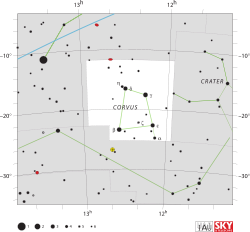Corvus (constellation)
| Constellation | |

|
|
| Abbreviation | Crv |
|---|---|
| Genitive | Corvi |
| Pronunciation |
/ˈkɔːrvəs/, genitive /ˈkɔːrvaɪ/ |
| Symbolism | the Crow/Raven |
| Right ascension | 12 |
| Declination | −20 |
| Family | Hercules |
| Quadrant | SQ3 |
| Area | 184 sq. deg. (70th) |
| Main stars | 4 |
|
Bayer/Flamsteed stars |
10 |
| Stars with planets | 3 |
| Stars brighter than 3.00m | 3 |
| Stars within 10.00 pc (32.62 ly) | 1 |
| Brightest star | γ Crv (Gienah) (2.59m) |
| Nearest star |
Ross 695 (28.99 ly, 8.89 pc) |
| Messier objects | 0 |
| Meteor showers |
Corvids Eta Corvids |
| Bordering constellations |
Virgo Crater Hydra |
|
Visible at latitudes between +60° and −90°. Best visible at 21:00 (9 p.m.) during the month of May. |
|
Corvus is a small constellation in the Southern Celestial Hemisphere. Its name means "raven" in Latin. One of the 48 constellations listed by the 2nd-century astronomer Ptolemy, it depicts a raven that has been associated with the god Apollo and is perched on the back of Hydra the water snake. The four brightest stars, Gamma, Delta, Epsilon, and Beta Corvi form a distinctive quadrilateral in the night sky.
With an apparent magnitude of 2.59, Gamma Corvi—also known as Gienah—is the brightest star in the constellation. It is an aging blue giant around four times as massive as the Sun. The young star Eta Corvi has been found to have two debris disks. Three star systems have exoplanets, and a fourth planetary system is unconfirmed. TV Corvi is a dwarf nova—a white dwarf and brown dwarf in very close orbit.
In the Babylonian star catalogues dating from at least 1100 BCE, what later became Corvus was known as the Babylonian Raven (MUL.UGA.MUSHEN). It was similarly placed sitting on the tail of the Serpent (Greek Hydra). The Babylonian constellation was sacred to Adad, the god of rain and storm; in the second Millennium it would have risen just before the start of the autumnal rainy season. John H. Rogers suggests that Corvus and Crater marked the gate to the Underworld. These two constellations, along with the eagle Aquila and the fish Piscis Austrinus, were introduced to the Greeks around 500 BCE.
...
Wikipedia
